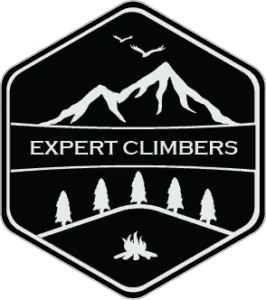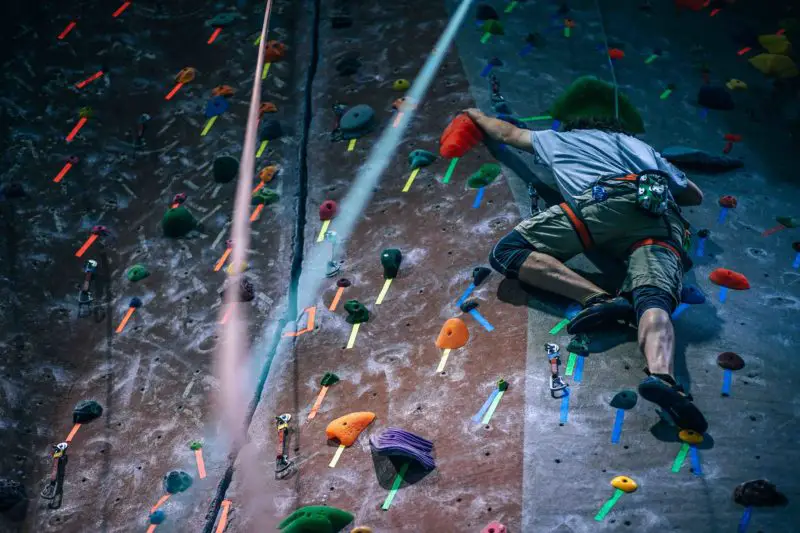Whether you’re just looking for a great strength and cardio workout or if you’re just pushing your limits while having fun, bouldering might just be your thing.
But what exactly is bouldering?
Bouldering is a form of rock climbing that is performed without the use of ropes or harnesses, either outdoors on small rock formations or indoors on climbing walls, also known as boulders, which are artificially constructed surfaces, fitted with a variety of hand and footholds.
Bouldering was originally aimed at helping climbers in practicing specific moves, while staying at a fairly safe distance from the ground (approximately 4m or 13.12 feet).
That being said, here are 12 bouldering tips for beginners.
1- Use your toes while climbing
One of the most common mistakes you can see at the climbing wall is people using their midsole instead of their toes, which restricts their movement and offers less traction.
Using your toes can offer the added flexibility of pivoting your foot but it will also help increase your overall reach when you go on the tip of your toes.
Climbing shoes are specially designed so that you can stand on small holds, using, you guessed it… your toes. If you try to stand on your midsoles you could slip right off causing some serious injury.
2- Use your legs to push yourself up
Your leg muscles are some of the biggest muscle groups in your body and leveraging them can go a long way in helping you conquer any wall.
You don’t need to let your arms do all the work of pulling your entire bodyweight. Sometimes you just have to push with your legs to be as efficient as possible.
If you’re trying to climb a slab wall, you can use your legs to push yourself up instead of simply dragging yourself up with your arms. If you are climbing an overhang, it’s really important to use your legs to push yourself towards the footholds. Using a combination of pushing with your legs and a bit of momentum to swing yourself towards the next hold.
3- Keep your hips close to the wall
A lot of new climbers let their hips sag away from the wall, which is totally normal, considering the fact that we humans stand vertically. The problem is that this will keep your center of gravity farther off the wall, which ultimately reduces the weight bearing ability of your legs and toes, thus transferring most of the weight to your fingers and forearms.
Your leg muscles are physiologically larger than those of your arms making them more effective in carrying your weight while climbing, but leveraging their strength will also help you distribute the weight more evenly, which saves you a lot of energy.
If it feels awkward at first, don’t worry, you just need to get used to the fact that your body is facing to the side instead of the wall.
4- Know your gripping techniques and holds
While training in a climbing gym you’re going to see a lot of different holds. There are numerous ways to hold them and various hand positions to use.
Here are a few of the different holds and some of the techniques to hold them:
Holds:
– Slopers: These are simply sloping handholds.
You should try to keep your center of gravity underneath the sloper and maximize the amount of surface contact you’re getting.
Some Slopers can be pushed against with your thumb facing down and that position is called a Gaston.
– Jugs: This is a big positive hold. Jugs that can be grabbed from the bottom are called underclings, which you can pull up on.
– Pockets: as the name suggests, tiny recesses in the wall, which you can fit your fingers in to hold on. There are 1, 2 and 3-finger pockets
– Crimps: it’s a really small edge that you’re only going to get your fingertips on; wrap your thumb over your index finger to maximize the pressure you can put on the small hold.
– Pinches: it’s a hold that you’re literally pinching by engaging your thumb.
– Underclings: these are all the holds that are facing to the ground
– Matching hands: this is a position where you put two hands on the same hold.
– Side pulls: in this technique, you’re pulling sideways on a hold.
– Gastons: it derives its name from the French climber Gaston Rebuffat, this hold is similar to a side pull only that your fingers and palms are now facing into the hold, while your thumb should be pointing downwards.
Gripping techniques:
There are 3 ways to grab handholds:
– Pull down
– Pull up
– Pull sideways
When you get tired, you’ll tend to firmly grab the hand holds. You should always remember that your legs have to do most of the work and that your hand holds will help you maintain your balance, making your fingers act like balance hooks.
However, you’ll have to use your fingers more extensively once you advance to more serious climbs.
5- Keep your arms straight while climbing
Bending your arms while climbing will cause them to fatigue quicker, as you’d end up engaging your forearms, through your biceps and shoulders, all the way up to your back with each move, whereas, if you climb with straight arms it can help you relax and evenly propagate the weight on your legs and upper body.
You should also avoid grabbing the holds at chest level and bending your arms at the elbows as that would exert too much strain on your biceps muscle causing your arms to tire much faster.
Try to climb with straight arms, each time reaching for the next hold and only bending and engaging the arms of your muscles when absolutely necessary. Your arms should remain straight as most of the work should be done through turning.
6- Read your climbing route
Take a moment to find your ideal climbing path, there’s no point in finding the start holds and jumping right in, while trying to work your way out along the way. Doing that will cause you to waste precious energy and you’ll end up tiring your arms in the process, which will hinder you from reaching the top.
Before you start climbing, look for the best route and try to figure out which hand is going to grab which hold. Doing this will make it a lot easier. Beginners usually have a variety of ways for a given problem, the more difficult routes however (5.10 and up), only have 1 or 2 sets of moves.
7- Don’t use too much chalk
Chalk can help absorb the moisture on your hands to keep them dry, giving you a better grip.
Try not to use too much chalk while bouldering, this goes for liquid as well as loose chalk. Using too much can have a negative impact on the traction you have on the holds.
This is especially important for liquid chalk, using too much can cause it to take a long time to dry and you might end up climbing with wet hands.
Whereas using too much loose chalk will give you the feeling that you’re climbing on dust causing you to possibly slide due to lack of traction, so just dip your fingertips slightly in your chalk bag, don’t take the chalk out, but rather swoosh your hand around inside the bag to get a bit of a coating and rub your hands against each other. Before you climb, it’s a good idea to rub off some of the excess.
8- Don’t be afraid to fail
Falling can sometimes be a good thing, when you fall, it just means that you’re trying hard and becoming a better climber, you should just focus on improving your technique because, as cheesy as it seems, practice makes perfect.
Work on your weaknesses, if you can’t hold on to the sloper, dedicate yourself to getting better by working more on it, if you fall off, that is absolutely fine.
“Falling and failing are as much a part of climbing as getting to the top.”
SHAUNA COXSEY
Temporary failure is a sign of improvement and persistence is key.
9- Climb with different people to learn new moves or betas
A beta is a sequence of moves. Your climbing skills will improve a lot faster if you climb with other people.
Different people have different skillsets, some have good dynamics, others are more static. What’s important is to try to climb with people that are more experienced than you even if they’re working on different problems.
Don’t be afraid to ask others for advice. You’ll find that most climbers are more than happy to help if you just ask, although it’s a competitive sport, your main adversary should be yourself, constantly trying to improve and conquer your fears and doubts.
10- Don’t focus on training a specific muscle, just climb and have fun
If you’re just starting out, your main focus should be on climbing and enjoying the experience, it’s the best way to build strength and confidence. If you start training too soon, you’ll end up hurting yourself tweaking a finger or pulling a muscle. For now as a beginner, the best thing is to get on the wall and start climbing.
Climbing muscles take quite a bit of time to develop, so patience is very important. I for one felt weak after 2 runs, my fingers became sore and my forearms started burning when I started.
It’s just that the forearms aren’t used to this kind of strain in our everyday lives, but at the end it’s all about having fun, so don’t take it too seriously and enjoy yourself.
11- Don’t forget to take rests
Taking frequent rests while climbing can be a very smart choice. A lot of novice climbers take resting for granted, however, it plays a paramount role in keeping you energized, strong and most importantly, injury free.
But how often should you rest while climbing?
The answer is, it depends.
While bouldering, you should generally take 3-5-minute rests between your attempts; this will keep you fresh and reduce cumulative fatigue, any less and you’ll probably be still fatigued from your last go, which will cause your subsequent performance to deteriorate. This can be quite problematic as you might end up so fatigued that you won’t be able to recover, leading you straight to the exit and back home.
Additionally, you should take 30-minute rests every hour.
If you push yourself to the limits, you’ll need to take longer breaks to help yourself recover, these can be 10 minutes or longer.
You should also avoid sitting down immediately after you’ve climbed, as standing can help with your blood flow.
If you find yourself losing sleep or experiencing persistent soreness in your muscles, or blisters in your skin, you should rest a bit more in between your climbing days, to avoid overtraining.
12- Invest in a good pair of shoes
The right fit is very important, if your shoes are too big, you’re unlikely to see any progress, as you won’t be able to stand on the holds or properly use your toes. If your shoes are too small, you’ll be in too much pain so make sure your climbing shoes are snug, so that you can feel the edges of the rocks or holds you’re climbing.
It’s quite common to wear shoes that are one size down from your usual size, one thing to be weary about is that they don’t cut off circulation.
My advice would be to have them fitted by a professional instead of buying them online, that way you’ll be sure to get the right size and style.
I hope you found this article helpful and if you have any thoughts or questions, feel free to leave me a comment down below and share it with your friends 😊
Happy bouldering and stay safe!

